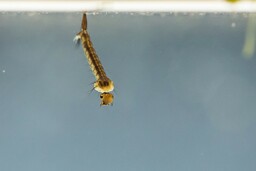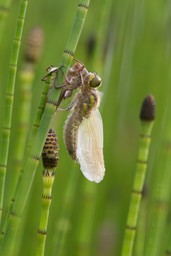6. Invertebrates
Contents
6.1 How are animals classified?
 The individuals of a species often look alike: they have a similar colouring and structure. For example, the small tortoiseshell species of butterfly (Aglais urticae) is easy to distinguish from the common brimstone species of butterly (Gonepteryx rhamni). The individuals of a species recognize each other and are able to reproduce with one another.
The individuals of a species often look alike: they have a similar colouring and structure. For example, the small tortoiseshell species of butterfly (Aglais urticae) is easy to distinguish from the common brimstone species of butterly (Gonepteryx rhamni). The individuals of a species recognize each other and are able to reproduce with one another.
A group of animals consists of multiple related species. For example, hundreds of butterfly species are found in Finland. Smaller groups of animals link together to form larger groups of animals. For example, butterflies belong to the group of insects along with beetles, dragonflies, and other similar organisms.
Each species belongs to these kinds of groups. For example, the small tortoiseshell is:
- an animal.
- an invertebrate.
- an arthropod (phylum).
- an insect (class).
- a butterfly (order).
- the small tortoiseshell (species).
6.2 Invertebrates in water ecosystems
Invertebrates are animals that have no internal supporting structure or skeleton.
Invertebrates do not possess well-developed senses. Their circulatory and respiratory systems are inefficient. These factors explain why invertebrates are often quite small.
Water ecosystems are home to a large number of invertebrate species. In addition to the very small zooplankton, many larger invertebrates are also found in water ecosystems. Many water-dwelling invertebrates, such as snails, crabs, and clams have hard shells.
Species of crustaceans, molluscs, and worms are common in water ecosystems. In addition to these, insects and spiders can also be found living in the water. The majority of insects live in the water during their larval stage, but for some species water ecosystems are an important habitat also in maturity.

The liver fluke snail is an invertebratic mollusc.
Most small invertebrates live on the water's surface. Pond skaters and whirligig beetles are examples of such species. Other invertebrates live under the water's surface, where algae and aquatic plants give them protection from predators. Clams, molluscs, and crabs dwell on the bottom of water ecosystems. Jellyfish can be found in the Baltic Sea.
6.3 How to get oxygen under water?
When you dive underwater, you must hold your breath. This makes it hard for humans to stay underwater for long periods of time. As oxygen is scarce under water, why can such a large number of species thrive in water ecosystems? How do these animals get their oxygen?
Many water-dwelling animals have gills. Gills are respiratory organs that filter oxygen from water and remove carbon dioxide from the organism.
Watch the video. Can you find gills? How do they work? Are the animals in the video crustaceans or insects?
Some insects, such as water beetles, have no gills. As a result, they must occasionally come up to the surface to breathe in oxygen from the atmosphere with their breathing tubes.

A water beetle coming up to the surface to breathe.
6.4 Metamorphosis
Some insects lay eggs in the water. The larvae of these kinds of species develop in water ecosystems. The insects that do so are called water insects. Mosquitoes and dragonflies are water insects, as their eggs and larvae develop in water.
The development from an egg into a mature insect is an example of metamorphosis. There are two types of metamorphosis.
A mosquito hatches from an egg and develops under water as a larva. Finally, the larva encases itself in a structure called a pupa. The pupa hatches into an adult mosquito that is once again capable of flying and laying eggs. This kind of process is called a complete metamorphosis. In the image gallery below, the complete metamorphosis of a mosquito is explained in pictures.
Like a mosquito, a dragonfly larva is hatched from an egg. The dragonfly larva grows in size under the water before climbing a plant stem to the surface. When the larva is above the surface, it hatches into an adult dragonfly. This process is called an incomplete metamorphosis.
An incomplete metamorphosis differs from a complete metamorphosis in that it lacks a pupal stage. In the image gallery below, the incomplete metamorphosis of a dragonfly is explained in pictures.

Dragonfly larva live under water.












